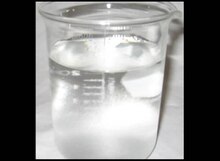Swelling
As swelling , swelling or sources , a physical process is known in which a substance (usually a liquid , but also gases or vapors) into a solid body penetrates, and a volume increase of the latter causes.
Typical substances that tend to swell are polymers , wood , unfired clays , bentonite , cardboard , or composites made with natural fibers .
In the case of hydrophilic polymers such as proteins (e.g. gelatin ) or carbohydrates (e.g. starch or cellulose derivatives ) or polyacrylates ( superabsorbents ), it is usually water that acts as a swelling agent. The water molecules are bound to polar groups via hydrogen bonds , which increases the distance between the polymer chains. The swelling can either lead to a solution of the polymer (e.g. in the case of gelatine in warm water) or, if the polymer is crosslinked , to a so-called hydrogel .
For example, the swelling of sheet silicates ( clay ) by water is known from the inorganic sector .
Hydrophobic polymers such as rubber are hardly swollen by water, but more strongly by organic solvents and lose their strength, possibly - if the tensile stresses that occur exceed the strength of the material - until the structure is destroyed. The degree of swelling is determined by measuring the
- Mass change
- Volume change
- Change of dimensions
Swelling processes are mostly endothermic , but exergonic . This can easily be based on the swelling of starch in water show that already voluntarily takes place at room temperature, but an increase in temperature (energy) increases .
They are also reversible as long as the swelling agent can escape from the solid again (e.g. by evaporation).
See also
- Swelling , an irreversible formation of folds and waves in flat film material
- Delay (mechanics)
Web links
Individual evidence
- ^ Fritz Röthemeyer, Franz Sommer: Kautschuktechnologie , Carl Hanser Verlag Munich Vienna, 2nd edition, 2006, pp. 527-528, ISBN 978-3-446-40480-9 .
